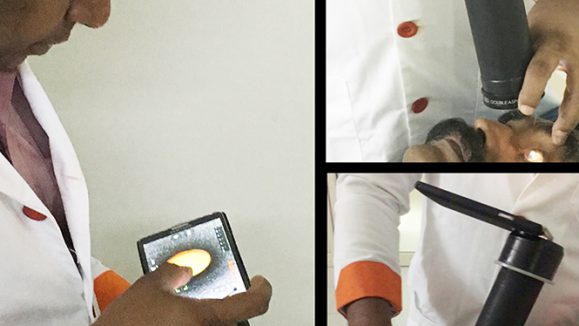Improvement and innovation are constant in the medical field. This is especially evident in ophthalmology, where new technology (including surgical devices and imaging systems) is regularly emerging. And as experts in the field, ophthalmologists are well suited to address current needs and create new instrumentation.
Dr. Samir Sayegh, the medical director of The EYE Center (Chicago-area, USA), is one such expert. He saw a need for a new surgical device – and thus, began researching to bring this invention from idea to fruition. Dr. Sayegh teamed up with a Boston-area patent attorney Wendy Thai, and together they collaborated to obtain three United States patents for his device.
PIE Magazine spoke with Drs. Sayegh and Thai about the process of applying for a patent. And while these tips specifically speak to applying for a patent in the United States, some of these tips may apply internationally.
Tip #1: Act Promptly – File as Soon as Possible
If you think you have an invention you’d like to protect with a patent, you want to act promptly. According to Dr. Thai, it is not enough to have invented, you must be the first inventor to file a patent application. And you know your invention is ready for patenting if you can answer three questions:
- What does it look like structurally?
- How do you make it?
- How do you use it?
“Once the inventor can relay in words . . . on paper using drawings as needed . . . what the invention looks like, how to build it, and how to use it, he is ready for the patent process,” added Dr. Thai.
Tip #2: Timing is Crucial
Patent laws vary from country to country. Some provide a period of time to file a patent application after the invention is made public. Others do not, and in these countries, patent rights are lost when the invention is made public.
“If you have an idea, it is best to file a patent application before any public disclosure. US laws provide a one-year grace period to file a patent application once the invention is publicly available, but this is not so in many countries. To preserve patent rights, it is best to file a patent application before sharing the invention with others. To preserve U.S. patent rights, you must file an application within one year of a public disclosure,” said Dr. Thai.
Tip #3: Collaborate with a patent attorney.
Just as ophthalmologists are highly specialized experts in their field, patent lawyers practice in a fairly specialized legal area. “Although U.S. laws do not say an inventor must use an attorney to file a patent application, a patent is a pretty complex technical and legal document” explained Dr. Thai.
Drs. Sayegh and Thai say that applying for a patent is a collaborative process. “It requires input from the technical expert and the legal specialist,” said Dr. Thai. “The inventor provides technical guidance on what the invention is, how to make it, and how to use it, and the attorney provides the know-how for protecting that.”
It’s also important to select an attorney who has the background to understand the invention. Each patent attorney has a technical background. For Dr. Thai, it’s the life sciences – with a Ph.D. in biology, she has the background to understand Dr. Sayegh’s ideas and its application. She also mentions that some inventions may be cross-disciplinary. For example, you might have a surgical device with mechanical parts that utilize computer software or systems to operate fully. In this instance, more than one attorney might be involved in preparing the application and guiding it through the patent office.
Tip #4: Pay attention to the patent literature
According to Dr. Thai, your patent application will be examined to determine if the claimed invention is new and non-obvious before a patent is granted. She suggests paying attention to the patent literature, not just scientific journals, before and after you file your patent application: “It can take years to get a patent. You don’t want to continue to put forth resources trying to patent something someone else has patented or have tried to patent,” she said.
“It is also important to understand that this does not mean you have to exhaustively complete background research before you can apply for a patent. Not at all. First, you must file your application before someone else does and within one year of a public disclosure in the U.S. Second, it is not possible to be exhaustive. Inventors actually have no legal obligation to conduct any research before filing a patent application. In my experience, inventors are almost always up to date on the scientific literature. I would just suggest paying attention to the patent literature as well,” explained Dr. Thai.
Tip #5: One patent can beget another.
For Dr. Sayegh, one discovery led to three patents – which is not unusual. One of his patents, “Eye Fixation System for Anterior and Posterior Surgeries and Procedures,” can be used in anterior segment surgery (including cataract surgery and refractive surgery) as well as for vitreoretinal procedures and posterior segment surgeries (like vitrectomy and intravitreal injections). The invention provides a universal tool for stabilization, fixation and accurate positioning and manipulation of other instruments. He also holds two related patents for a “Positioning Device for Eye Surgery and Procedures.”
“The initial discovery can lead to modifications that allow us to have patents covering slightly different variations of the initial discovery. When you file a patent application, that first application can form the basis for additional filings of ‘child’ applications. The parent and child applications issue into patents that have different scope of coverage,” explained Dr. Thai. “We can file as many applications as necessary to fully protect the invention.”
Dr. Sayegh is currently courting manufacturer interest for his patents: “Having a patent not only protects your idea, it also makes larger companies more comfortable with manufacturing your device,” he said.
For more information on applying for a U.S. patent, visit www.uspto.gov.




